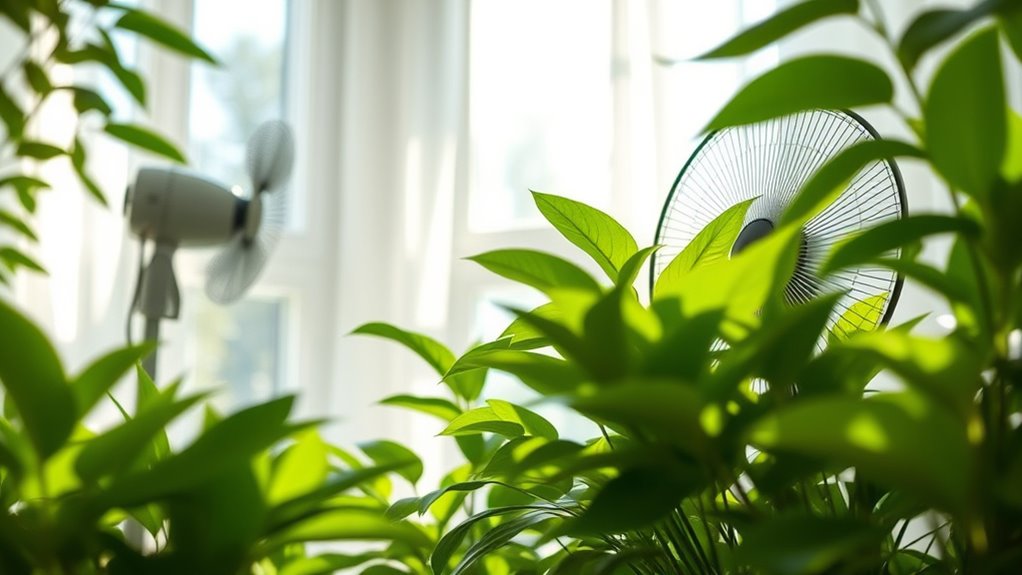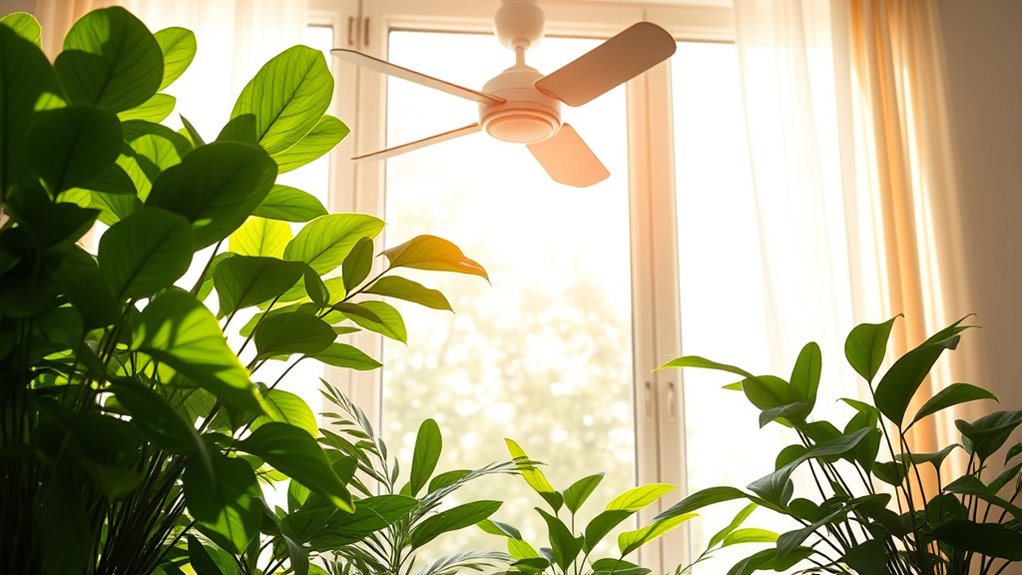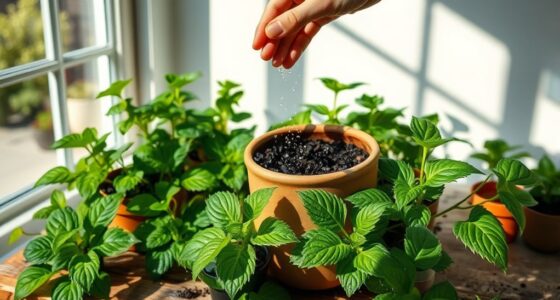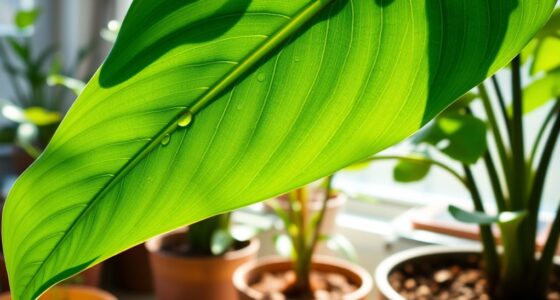Proper airflow and ventilation are key to healthy indoor plants. They help regulate humidity, prevent mold and disease, and guarantee consistent temperatures. Good circulation also removes airborne pollutants and pests, creating a safer environment for your plants. By controlling moisture and air quality, you reduce stress on your greenery and promote vigorous growth. Keep airflow in check, and you’ll create an ideal environment—learn more on how to perfect your ventilation system.
Key Takeaways
- Proper airflow prevents stagnant humidity, reducing mold growth and maintaining ideal moisture levels for healthy plants.
- Effective ventilation removes airborne pollutants and spores, promoting cleaner air and reducing disease risk.
- Good air circulation stabilizes temperature and humidity, preventing stress and supporting optimal plant growth.
- Adequate ventilation minimizes excess moisture, decreasing the chances of fungal infections and pest infestations.
- Consistent airflow mimics outdoor conditions, encouraging stronger, healthier plants and a balanced indoor environment.

Have you ever wondered how proper airflow and ventilation keep indoor spaces healthy and comfortable? When it comes to maintaining a thriving environment for your indoor plants, good airflow does more than just prevent stuffiness. It plays a essential role in humidity control, ensuring that the air around your plants isn’t too damp or too dry, which can cause issues like mold or dehydration. Proper ventilation helps regulate moisture levels, creating a balanced atmosphere that promotes healthy growth and prevents pests or diseases from taking hold. Without enough fresh air moving through your space, humidity can become stagnant, fostering mold or fungal growth that could harm your plants. Conversely, too little moisture can lead to wilting and leaf damage. That’s why managing humidity through strategic airflow is necessary.
Proper airflow balances humidity, preventing mold and dehydration to keep indoor plants healthy and thriving.
Additionally, good ventilation supports air purification, which is critical for indoor plant health. As indoor air circulates, it helps remove pollutants, dust, and airborne spores that can settle on leaves or in the soil, potentially causing problems. Clean air means your plants are less likely to suffer from respiratory stress or leaf spots caused by airborne contaminants. Ventilation systems equipped with filters can further enhance air purification, trapping allergens and pollutants before they reach your plants. This continuous movement of fresh air ensures your indoor environment stays vibrant and healthy, reducing the risk of problems linked to poor air quality. Proper airflow also influences projector performance, as consistent air circulation helps maintain stable temperatures and prevent overheating of electronic components.
You should also consider how airflow impacts temperature regulation. Proper circulation prevents hot spots and drafts, maintaining a consistent temperature that’s ideal for your plants. Sudden temperature swings can stress plants and inhibit growth, but with good ventilation, you create a stable climate that supports steady development. Think of your ventilation setup as a way to mimic outdoor conditions, where natural breezes help disperse heat and humidity evenly across the landscape.
In essence, good airflow isn’t just about comfort for you—it’s about creating an ideal environment for your plants to flourish. It ensures humidity stays within the right range, prevents excess moisture buildup, and promotes air purification, all of which are necessary for healthy indoor gardening. By paying attention to ventilation and making sure air moves freely and continuously, you give your plants the best chance to thrive. Proper airflow means healthier, happier plants and a more comfortable living space for you.
Frequently Asked Questions
How Does Airflow Affect Pest Control in Indoor Plants?
Good airflow plays a key role in pest prevention for your indoor plants. When you guarantee proper air circulation, it discourages pests like mites and fungus gnats, which thrive in stagnant, humid conditions. By keeping the air moving, you make your plants less inviting to pests, making it easier to control infestations. So, regularly ventilate your space to promote healthier, pest-free plants and maintain a balanced environment.
Can Too Much Ventilation Harm Delicate Indoor Plant Species?
They say too much of anything isn’t good, and that’s true for ventilation too. Excessive ventilation can harm delicate indoor plant species by causing airflow damage, leading to stress or dehydration. While good airflow is essential, too much can dry out leaves and roots. You should balance ventilation to avoid overwhelming your plants, ensuring they get just enough air without risking damage from excessive airflow.
What Are the Best Tools to Measure Indoor Airflow?
To measure indoor airflow effectively, you should use ventilation tools designed for airflow measurement. A an anemometer is ideal because it gauges airspeed accurately, helping you understand circulation levels. Another useful tool is a airflow meter, which provides precise readings of air volume in a space. These ventilation tools enable you to monitor and optimize airflow, ensuring your indoor plants receive the proper air circulation without risking damage from excessive or insufficient airflow.
How Can I Simulate Natural Outdoor Airflow Indoors?
Think of your indoor space as a miniature breeze factory. To simulate natural outdoor airflow, you can open windows regularly and use oscillating fans to mimic wind currents. Adjust fan speed and placement to create dynamic airflow patterns that promote air exchange without causing drafts. This movement encourages fresh air to circulate, preventing stagnation and helping your plants breathe freely, just like they would outside.
Does Airflow Impact the Humidity Levels Around Indoor Plants?
You might wonder if airflow affects humidity levels around your indoor plants. Yes, air movement can influence humidity balance by helping to prevent excess moisture buildup, which can lead to mold or disease. Proper airflow ensures that humidity stays consistent, avoiding overly damp conditions or dry spots. By maintaining good air circulation, you create a healthier environment for your plants, promoting ideal growth and reducing the risk of problems caused by fluctuating humidity levels.
Conclusion
Think of airflow and ventilation as the gentle breeze that breathes life into your indoor jungle. When you give your plants the right circulation, you’re releasing their full potential—like a secret recipe for lush, vibrant growth. Without it, they struggle like a sail without wind. So, let the air flow freely, and watch your plants thrive as if they’re dancing in a warm, invigorating wind—bringing beauty and energy into your home every day.











